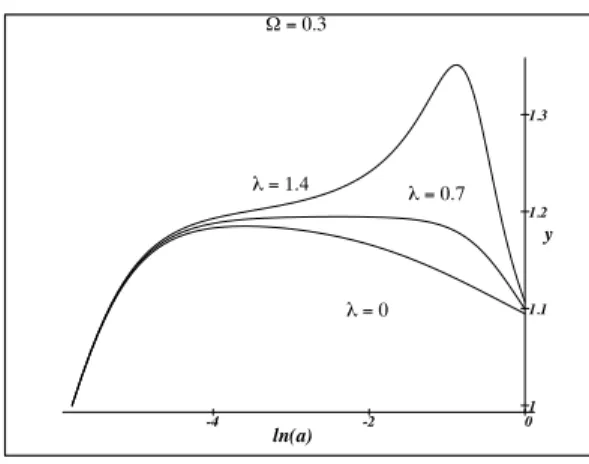HAL Id: hal-00089276
https://hal.archives-ouvertes.fr/hal-00089276
Submitted on 16 Aug 2006
HAL is a multi-disciplinary open access
archive for the deposit and dissemination of
sci-entific research documents, whether they are
pub-lished or not. The documents may come from
teaching and research institutions in France or
abroad, or from public or private research centers.
L’archive ouverte pluridisciplinaire HAL, est
destinée au dépôt et à la diffusion de documents
scientifiques de niveau recherche, publiés ou non,
émanant des établissements d’enseignement et de
recherche français ou étrangers, des laboratoires
publics ou privés.
SPHERICAL VOIDS IN NEWTON-FRIEDMANN
UNIVERSE
Roland Triay, Henri-Hugues Fliche
To cite this version:
Roland Triay, Henri-Hugues Fliche. SPHERICAL VOIDS IN NEWTON-FRIEDMANN UNIVERSE.
Proceedings of the Eleventh Marcel Grossmann Meeting on General Relativity, 2007, Berlin, Germany.
�hal-00089276�
ccsd-00089276, version 1 - 16 Aug 2006
August 16, 2006 17:35 WSPC - Proceedings Trim Size: 9.75in x 6.5in main.hyper12330
1
SPHERICAL VOIDS IN NEWTON-FRIEDMANN UNIVERSE
R. TRIAY
Centre de Physique Th´eorique ∗
CNRS Luminy Case 907, 13288 Marseille Cedex 9, France ∗E-mail: triay@cpt.univ-mrs.fr
www.cpt.univ-mrs.fr H. H. FLICHE
LMMT†, Fac. des Sciences et Techniques de St J´erˆome av. Normandie-Niemen, 13397 Marseille Cedex 20, France
E-mail: henri-hugues.fliche@wanadoo.fr
The understanding of voids formation, which is at the origin of the foam like pat-terns in the distribution of galaxies within scale up to 100 Mpc, has become an im-portant challenge for the large scale formation theory.23 Such a structure has been observed since three decades and confirmed by recent surveys.4,5,7,14–16,25,27 Investi-gations has been performed – on their statistical properties by improving identification techniques,24by exploring their formation process in a Λ CDM model through N-body simulations,3,11,12,19,22,26,29 by probing their origins;21 – on the kinematics of giant voids17and the dynamics by testing models of void formation.1,2,10Herein, we investi-gate the effect of the cosmological constant Λ on the evolution of a spherical void through an exact solution of Euler-(modified) Poisson equations system (EPES).9 Let us remind that Friedmann-Lemaˆıtre models, which provide us with a suitable description of the universe at large scales (thanks to their stability with respect to linear perturbations18), can be described within a Newtonian approach by means of EPES solutions for whom kinematics satisfy Hubble (cosmological) law. The void consists of three distinct media : a material shell (S) with null thickness and negligible tension-stress, an empty inside and a uniform dust distribution outside which expands according to Friedmann equation. We use a covariant formulation of EPES6,28for deriving the evolution with time of S acting as boundaries condition for the inside and outside media.
As a result, S expands with a huge initial burst that freezes asymptotically up to matching Hubble flow. The related perturbation on redshift of sources located on S does not exceed ∆ z ∼ 10−3. In the Friedmann comoving frame, its magnification increases nonlinearly with Ω◦ and Λ. These effects interpret respectively by the gravitational attraction from the outer parts and repulsion (of vacuum) from the inner parts of S, with a sensitiveness on Ω at primordial epochs and on Λ later on by preserving the expansion rate from an earlier decreasing. This dependence of the expansion velocity ~
v= yH~ron Λ is shown on Fig. 1 through the corrective factor y to Hubble expansion, where ~rand H stand respectively for radius of S and Hubble parameter at time t. It is characterised by a protuberance at redshift z ∼ 1.7, the larger the Λ the higher the ∗Unit´e Mixte de Recherche (UMR 6207) du CNRS, et des universit´es Aix-Marseille I, Aix-Marseille II et du Sud Toulon-Var. Laboratoire affili´e `a la FRUMAM (FR 2291).
August 16, 2006 17:35 WSPC - Proceedings Trim Size: 9.75in x 6.5in main.hyper12330 2 !!"!#$% !!"!&$' !!"!& 1 1.1 1.2 1.3 y -4 -2 0 ln(a) "!"!&$(
Fig. 1. The corrective factor y to Hubble expansion. It results from a void that initially expands with Hubble flow at expansion parameter ai= 0.003, with Ω◦= 0.3. and Ωλ= λ = 0, 0.7, 1.4.
bump. It is due to the existence of a minimum value of Hubble parameter H which is reached during the cosmological expansion (also referenced as a loitering period). It characterises spatially closed Friedmann models that expands for ever, they offer the property of sweeping out the void region, what interprets as a stability criterion. Keywords: Cosmology : Theory, Cosmological Constant, Voids, Large Scale Structures.
References
1. N. Benhamidouche, B. Torresani, R. Triay Mon. Not. R. Astron. Soc. 302, 807 (1999)
2. K. Bolejko, Mon. Not. R. Astron. Soc. 370, 924 (2006)
3. J.M. Colberg, in Outskirts of Galaxy Clusters : intense life in the suburbs, Proc. IAU
Coll. 195, 51 (2004) A. Diaferio, ed.
4. C. Conroy, A.L. Coil, M. White, J.A. Newman, R. Yan, M.C. Cooper, B.F. Gerke, M.
Davis, D.C. Koo Astrophys. J. 635, 990 (2005)
5. D.J. Croton, M. Colless, E. Gaztaaga, C.M. Baugh, P. Norberg, I. K. Baldry, J.
Bland-Hawthorn, T. Bridges, R. Cannon, S. Cole, C. Collins, W. Couch, G. Dalton,
R. De Propris, S. P. Driver, G. Efstathiou, R. S. Ellis, C. S. Frenk, K. Glazebrook, C.
Jackson, O. Lahav, I. Lewis, S. Lumsden, S. Maddox, D. Madgwick, J. A. Peacock,
B. A. Peterson, W. Sutherland, K. Taylor, The 2dFGRS team, Mon. Not. R. Astron.
Soc. 352, 828 (2004)
6. C. Duval, H.P. K¨
unzle, Rep. Math. Phys. 13, 351 (1978)
7. PJ. Einasto, in Proc. of Ninth Marcel Grossmann Meeting on General Relativity, p.
291 . Edits. V.G. Gurzadyan, R.T. Jantzen, Ser. Edit. R. Ruffini. World Scientific
(2002)
8. H.H. Fliche, in ´
Evaluation des param`etres cosmologiques `
a l’aide des propri´et´e optiques
des quasars. Fluctuations des mod`eles de Friedmann-Lemaˆıtre, th`ese d’´etat – Univ.
de Provence (1981)
9. H.H. Fliche, R. Triay, arXiv:gr-qc/0607090, submitted to Gravit. Gen. Relat.
10. Y.Friedmann, T. Piran, Astrophys. J. 548, 1 (2001)
August 16, 2006 17:35 WSPC - Proceedings Trim Size: 9.75in x 6.5in main.hyper12330
3
